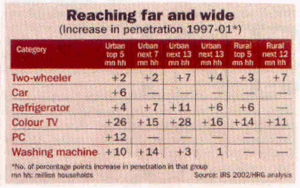According to the BRIC report by Goldman Sachs, over the next 50 years, Brazil, Russia, India and China – the BRIC’s economies- could become a much larger force in the world economy.
In less than 40 years, they together could be larger than the G6 (UK, Germany, Japan, US, Italy and France) in US dollar terms.
By 2025 they could account for over half the size of the G6. Currently they are worth less than 15%.
Of the current G6, only the US and Japan may be among the six largest economies in US dollar terms in 2050.The shift in GDP is most dramatic in the first 30 years. Growth for the BRIC economies is likely to slow significantly toward the end of the period, with only India seeing growth rates significantly above 5% by 2050. By that time it will be the third largest after China and the US in GDP terms but lowest in per capita GDP among the BRIC –G6 combine.
But what is most interesting is that the GDP size and relative income per capita levels will diverge over time. By 2050, barring India and China in the top ten by GDP, all others namely, US, Japan and the G6 countries, will have GDP per capita that is much higher than the country GDP. This implies a much greater emphasis on infrastructure for growth in India and China. Add to this the lowest proportion of urbanisation for these two countries and the drivers become obvious.
Another interesting thing that the report highlights is the projected annual GDP growth from 1960 to 2000. It is clear that among the under performers, India stands out. This makes a strong case for conditions for growth, these being – stable macro-economic policies, stable political institutions and high levels of education
As today’s advanced economies become a shrinking part of the world economy, the accompanying shifts in spending could provide significant opportunities for global companies. Investing in and being involved in the right markets – particularly the right emerging markets- may become an increasingly important strategic choice.
This article discusses some of the growth aspects of Indian markets.
The income distribution profile of both urban and rural India is changing. The high income households have been growing at a much higher rate than the middle classes.

Source: NCAER
Apart from a more affluent consumer there are several growth drivers for the economy. A big catalyst for the rise in consumer spending has been the spread of cable and satellite television. This has proved to be the most potent force in the ‘education’ of the masses’. With the world in their living room, consumers are learning the value of education, health, real value products and entertainment. Advertisers’ response (read ad spends) is the best testimony to the growing power of the medium in influencing consumer behaviour. There are over 80 million households (out of a 200 million) receiving the TV network. Pent up demand is most for electronic goods, white goods, two wheelers, cars and mobile phones.

The interesting statistics are that the growth in these is coming from right down the income strata.

Colour television, refrigerators, and two wheelers are really driving growth in both rural and urban sectors.
All this has been made possible with prices and interest rates coming down and availability of products at very low monthly installments; cell phones are available at Rs.500 EMI and you can drive out in a brand new Maruti 800 with just Rs.2000 in your pocket.

The rapid spread of the mobile phone culture has been driven by steadily falling tariffs – now 80% below introductory prices- and handset costs down 25-30%. Yet there are just over 40 million subscribers. So the potential is huge.
Serving and fuelling this consumerism is the emergence of organised retailing in India. With hypermarkets employing modern logistical management solutions, customers are also enjoying increased affordability. Consumers are beginning to find the convenience of one stop shopping, freedom to touch –feel products, better service worth a trip to the malls.
Easy consumer credit is driving growth in housing and durable purchases. Growth is going to be driven by software and IT enabled services, value added BPO services and health services. The relative cost of medical treatment is driving patients from both developed and developing countries to come to India. India also gets the highest remittances from diaspora abroad
Trained manpower, low labor and infrastructure cost makes India an attractive hub for manufacturing. Foreign auto companies and durable manufacturers are increasingly setting up facilities in India.
A sequel to the first report titled, India: realizing BRIC’s Potential, focuses on the structural reforms India will have to pursue to become the top performer among the four BRIC nations. Unfortunately, India currently lags behind the other BRIC economies in levels of openness, basic education and infrastructure.
